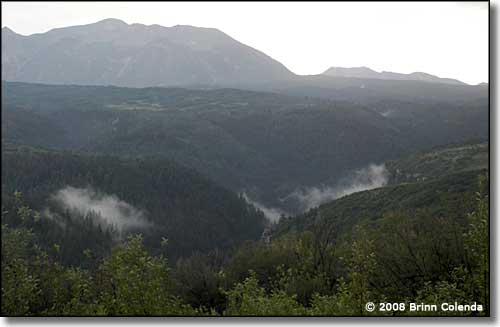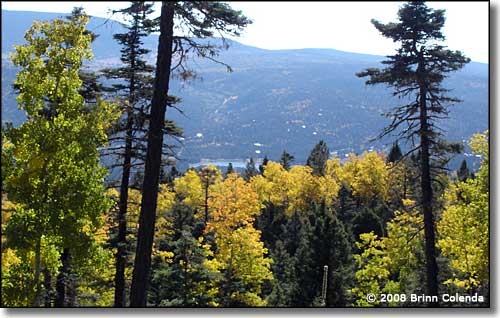 |
Minimal Impact Camping |
| - |
 |

I'm a firm believer (and follower) of the "Leave No Trace" ethic. I've spent enough time way out in the bush to have a sincere appreciation of "the way it was [before I came along] and the way it should be [after I'm gone]." So I'm adding this page of "advice" to the site in hopes that those who feel a need to carve their initials into the trees and leave their trash in the woods (yeah, even that stuff you thought burned up in the fire ring...) might learn to see things in a different manner. On the other hand, this is also just plain good info for those of us who just need a few reminders on how to make that trip into the bush a more pleasant experience (I got snowed on once on July 4th at 14,000 feet in Colorado, and I was so thankful that I'd at least brought a decent jacket up the hill with me). So then, step #1: plan the trip. Think about what you want to do, where you want to go and what you want to do there. Think about the weather and how that might affect you. Make sure you have proper gear (and enough of it) and make sure that gear all works for where you're going (nothing like trying to pound plastic tent stakes into a mossy rock pile). And a collapsible shovel is worth its weight in gold more often than you'd think. Step #2: plan your destination(s). Most places that are relatively easily accessed can see heavy use in season. And with everything being basically "first come, first served," you'll want to get there early, while there's still a place available for you where you want to be. Being early will also give you a better choice among the existing fire rings (if they are already there), you might not have to clean one out to make it usable. It's also better if you clean one out than if you make a new one... When you get there, you want to set up your camp at least 200' from any water, and probably the same distance (or more) from any roads or trails so you have some privacy. The distance to water is important so you don't risk contaminating the water. And when that black bear momma comes through with her 2 cubs, you don't want to be between them and the water either. 200 feet back and you're not as exposed, nor are you as much of a disturbance. It's also a lot easier to clean up the site and "leave no trace" when you're done. "Pack it in, Pack it out." There's probably no trash pickup out there. This includes the stuff you might want to put in the fire to burn up: quite often those food packages have a foil liner that just doesn't burn. Leaving the trash behind doesn't just make for an ugly site/sight, it also attracts wildlife and can be harmful to them. You brought it in, just take it back out. Human waste is another problem in the bush. I know in school they taught us all to flush but that doesn't work in the woods. So you're best off to dig a "cathole," and this is where you'll really value that collapsible shovel. Get away from the water (at least 300 feet) and off the trail (you don't really want someone stepping in it, do you?) Try to find a spot with a deep layer of organic material (to help decompose the feces). And the best spots are up the hill a bit (where the water doesn't pool) and where there's good sunlight (to also help decompose the stuff). Your cathole needs to be at least 6-8 inches deep and probably 4-6 inches in diameter. Keep looking for a spot until you can get the right depth and size. When you're done, fill the hole back in and try to make it disappear. As far as the toilet paper, "pack it in, pack it out" (rodents are very strongly attracted to toilet paper for some reason, especially if it's been used). Campfires: this is a big one. You may be a fully responsible adult, but so many others in the past weren't... that's why we so often find ourselves crossing old (and new) burns in the forests. If you've got to have a campfire, realize the enormity of the responsibility you're taking on (I usually travel with a small propane cooker and it does everything I need in that persuasion... and it's so much safer, easier and faster to cook on). But if you've got to have a fire, try to use an existing fire ring. If the one you find isn't in a good spot, move it (not under the branches of a tree nor up close to any rocks), and clean the former location so it disappears. If you have to build a new one, keep it small and unobtrusive. As for the firewood you're going to use, it's got to be either dead or naturally downed wood. Breaking the branches of a live standing tree leaves an ugly sight, and those branches don't burn well anyway. If you can't break it with your hands or by stepping on it, it's probably too large for your fire. Any wood you collect but don't burn: scatter it back through the trees and let it blend back in naturally. When you leave, leave the fire ring in better condition than you found it. That way, the next camper to come through after you will praise you for your efforts, and will hopefully be as respectful of the site as you were. |
 |
|
Another aspect of being "respectful" to the forest is to leave the wildlife alone: enjoy what you see but DON'T feed it. Especially bears. These woods are bear country, and when bears get too close to humans, they all too often end up dead. On the other hand, you may think you've got enough food with you to last for several days, but if you leave it where a bear can get at it, it won't last that bear more than a few minutes. So if you aren't carrying it, cooking it or eating it, lock it up in a bear-proof container (or hang it high from a tree branch well out of reach). Another thing about the wildife: there usually isn't so much rabies in the woods but there are usually lots of fleas... and fleas carry bubonic plague and hantavirus... and ticks. You don't want any of it: keep your distance, enjoy the view. The altitude of where you're going is another consideration. Elevation will make you breath faster and/or deeper. It'll make your heart beat faster, too. Exercise will aggravate the breathing and the heartbeat. Take your time, don't push. Give yourself some time to acclimate (and it may take a day or two). Drink more water and less alcohol, or coffee. Even without any alcohol you might feel hung-over. If that hang-over gets worse or just doesn't go away, first aid involves getting back down the hill to a lower elevation. Another aspect of altitude is sunburn: the air gets thinner and the harmful UV gets worse. Use some kind of protective cream. "Cold sores" are aggravated by the UV level, too. And your eyes: your eyes can easily get sunburnt even on a cloudy/foggy day at high elevation. Your sunglasses (or goggles) need to have good ultraviolet protection. These are just a few things to think about when you're planning a trip to the bush. I keep a backpack in the closet that has most of the regular stuff already packed in it. I just have to check the batteries in my GPS and camera, weigh the small propane tank, and then pack maps, food and clothes. |

|
| Index - Arizona - Colorado - Idaho - Montana - Nevada - New Mexico - Utah - Wyoming National Forests - National Parks - Scenic Byways - Ski & Snowboard Areas - BLM Sites Wilderness Areas - National Wildlife Refuges - National Trails - Rural Life Advertise With Us - About This Site - Privacy Policy |
| These 3 photos of northern New Mexico in the fall and early winter are from my good friend Brinn Colenda Text Copyright © by Sangres.com. All rights reserved. |